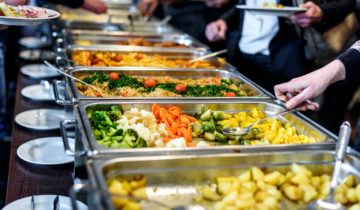Fibres, minerals, vitamins, carbohydrates, lipids… and of course proteins! The nutritional quality of their menus is one of the main challenges facing chefs who work in institutional catering. At the same time, they have to juggle multiple priorities such as:
-
superior flavour of the food for the diners’ pleasure
-
varied recipes, essential to ensuring they don’t get bored
-
the rising popularity of flexitarian or even vegetarian diets
-
time, team and inventory management.
Protein is one of the body’s basic needs, making it a pillar of any human nutrition. How can you easily incorporate protein into your menus? Here are some suggestions for you!
An essential component of a healthy diet
Protein plays a dominant role in the health and functioning of the human body: it helps build muscles of course but also contributes to bone structure, skin, cells in general, physiological processes like digestion, hormone production, and the list goes on. WHO recommends that protein should account for 10% to 27% of total caloric intake, or slightly more for pregnant and nursing women and for the elderly.
Protein can come from either animals or plants (lentils, quinoa, cereals, chickpeas, etc.). As a result of increasing concerns among diners regarding the impact of what they eat on their health and the environment, we are witnessing growing demand for meat alternatives (rise in flexitarianism and vegetarianism) and organic products. A main goal of institutional catering chefs is still to serve balanced meals, meaning they must include a share of protein.
Plant and egg proteins: Healthy, balanced food for all
Eggs and egg products are a great way to meet the basic need for protein, in multiple forms: as the main focus of a dish, as a side dish or as one of several ingredients mixed together. Many recipes, both traditional and more exotic, include eggs.
They can also help to bind plant-based proteins together. This can be necessary because cereals and legumes do not produce all the different types of amino acids. And these two food categories are not systematically combined. In this situation, the use of eggs can provide all the required nutrients and diversify the recipes being served, even for vegetarians!
Eggs and egg products: A chef’s best friend for every course of a meal
Used in starters, main courses, side dishes or desserts, the many forms of eggs can help to enhance your dishes and menus! Liquid egg and egg-based products allow institutional caterers to refresh their cuisine every day, thanks to the wide variety of available preparations:
-
scrambled eggs served with seasonal vegetables like asparagus, spinach, sweet peppers, etc.
-
salads garnished with hard-boiled or poached eggs
-
bagel sandwiches with fried eggs
-
cakes and pastries made with liquid egg (fresh or frozen), ready-to-use crêpes, etc.
The many packaging options we offer allow you to avoid any wastage and give you great freedom in using our products to save time in the kitchen.
Let protein-rich eggs and their nutritional characteristics help you offer healthy, tasty meals to your diners. Cocotine’s egg products, available chilled or frozen (IQF – individually quick frozen), and even organic, simplify the day-to-day work of institutional catering chefs, who know they can count on high-quality fare. Discover all of their benefits in the 100% quality chef’s kit!







